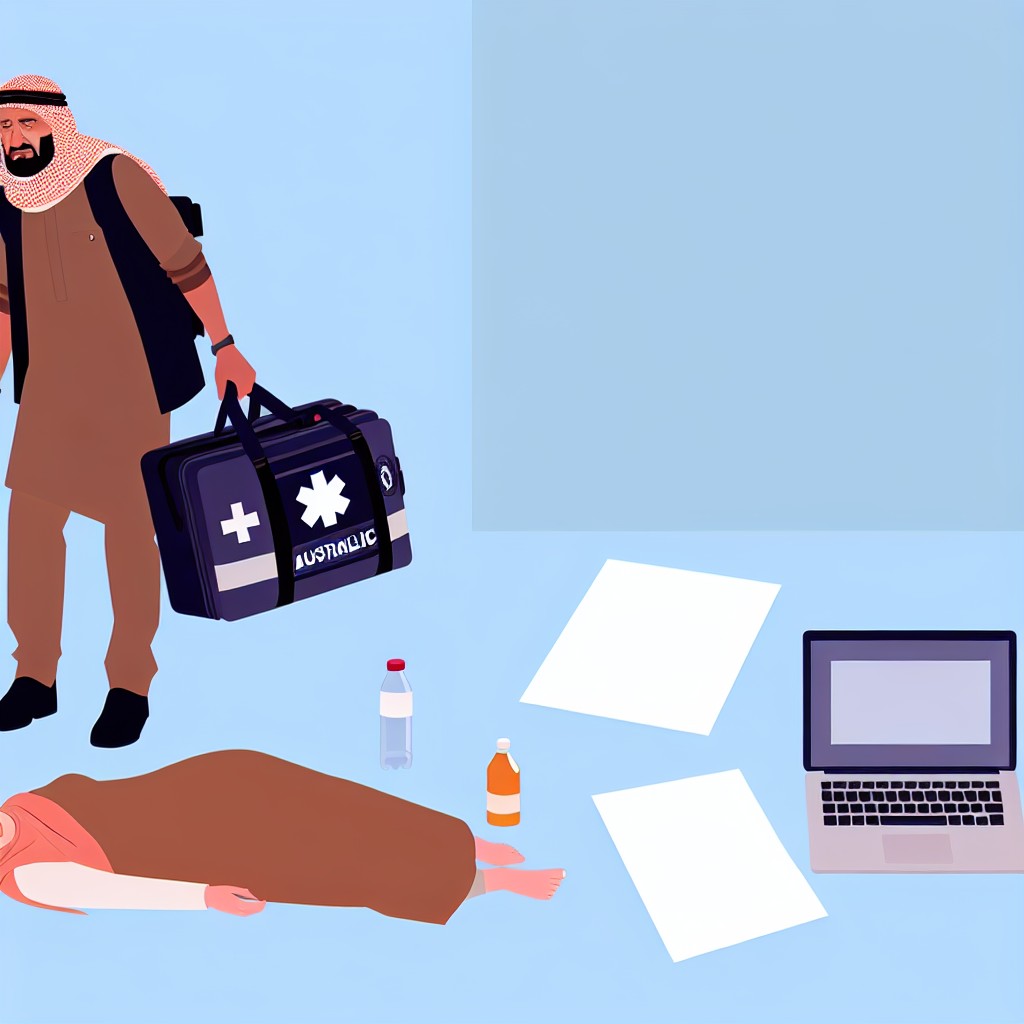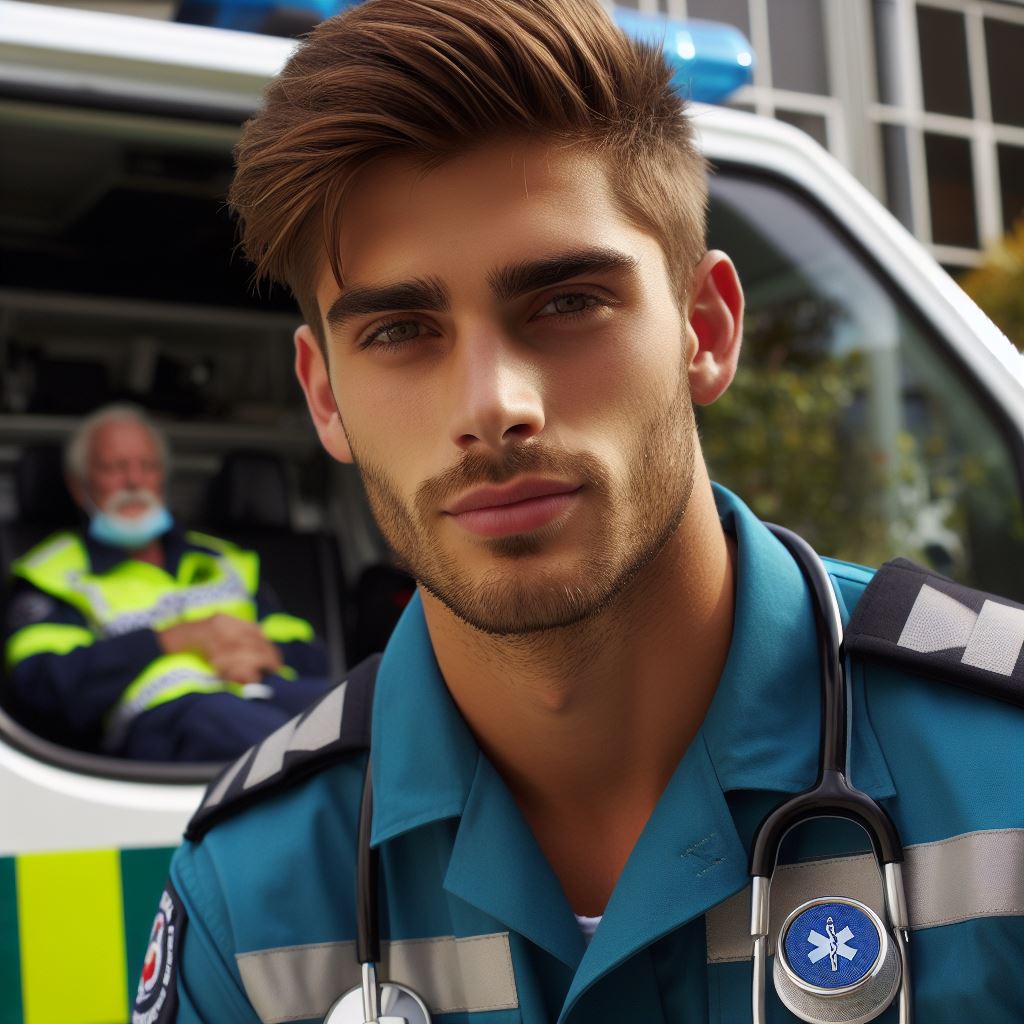Introduction to the Role and Responsibilities of a Paramedic
Core Duties of a Paramedic
A paramedic provides urgent medical care to patients in emergency situations.
They assess patient conditions quickly to determine necessary treatment.
Additionally, paramedics stabilize patients to prepare them for hospital transport.
They administer medications and perform advanced life support procedures when needed.
Moreover, paramedics document patient information accurately for ongoing care.
Work Environment and Team Collaboration
Paramedics operate in diverse environments, including ambulances and on-scene emergencies.
They work closely with emergency medical technicians, nurses, and doctors.
Effective communication with team members ensures seamless patient care.
Furthermore, paramedics collaborate with fire and police departments during crises.
They adapt quickly to changing situations to provide the best possible outcomes.
Skills and Personal Qualities Required
Paramedics must have strong critical thinking skills to make fast decisions.
They require excellent physical stamina due to the demanding nature of the job.
Compassion and empathy help paramedics connect with patients in distress.
Attention to detail is essential when administering treatments and recording data.
They must remain calm under pressure to handle emergencies effectively.
Your Personalized Career Strategy
Unlock your potential with tailored career consulting. Get clear, actionable steps designed for your success. Start now!
Get StartedTraining and Certification
Paramedics undergo rigorous training involving classroom instruction and clinical practice.
They learn anatomy, pharmacology, and emergency medical procedures extensively.
Certification processes vary but commonly include national or regional licensing exams.
Continuing education ensures paramedics stay updated on medical advancements.
This ongoing learning improves the quality and safety of patient care they deliver.
Typical Day-to-Day Tasks on Emergency Calls
Responding Quickly and Efficiently
Paramedics start each shift ready to respond immediately to emergencies.
They monitor dispatch radios constantly for urgent calls.
Upon receiving a call, they quickly gather necessary equipment and supplies.
The team drives swiftly but safely to the emergency location.
Every second counts when providing pre-hospital care to patients.
Performing Patient Assessments and Interventions
Paramedics assess patients’ vital signs and medical conditions upon arrival.
They look for signs of trauma, illness, or distress methodically.
Next, paramedics administer first aid and advanced medical treatments as needed.
They provide oxygen, control bleeding, and perform CPR when required.
Stand Out with a Resume That Gets Results
Your career is worth more than a generic template. Let us craft a resume and cover letter that showcase your unique strengths and help you secure that dream job.
Get HiredMoreover, paramedics prepare patients for safe transport to hospitals.
Documenting and Communicating Patient Information
Accurate documentation of interventions and observations is crucial.
Paramedics use electronic or paper forms to record patient data.
They communicate vital information to emergency room staff during handoff.
Clear communication ensures continuity of care at receiving facilities.
Additionally, paramedics update their supervisors about each call’s outcome.
Challenges Faced on Emergency Calls
Dealing with High-Stress Situations
Paramedics regularly work in emotionally and physically taxing environments.
They must remain calm under extreme pressure and chaos.
Stress management skills help them perform effectively on critical calls.
Furthermore, they often encounter distraught family members and bystanders.
Maintaining professionalism while offering reassurance is essential.
Handling Diverse Patient Conditions
Paramedics encounter a wide range of medical emergencies daily.
These include cardiac arrests, trauma injuries, strokes, and respiratory problems.
They must quickly adapt treatment based on each unique scenario.
Transform Your LinkedIn for Maximum Impact
Elevate your professional brand with a LinkedIn profile that attracts recruiters, showcases your expertise, and maximizes opportunities. Stand out in your industry with a profile built for success.
Boost ProfileAdditionally, challenging cases may involve pediatric or elderly patients.
Constant training ensures paramedics stay current with best practices.
Working in Unpredictable Environments
Emergency scenes often present unsafe or difficult conditions.
Paramedics may operate in traffic accidents, homes, or public spaces.
Weather, lighting, and physical hazards complicate their work.
They use personal protective equipment to stay safe during calls.
Moreover, teamwork helps manage complex or dangerous situations efficiently.
Training, Qualifications, and Ongoing Education Required to Become a Paramedic
Basic Educational Requirements
A high school diploma or equivalent is the starting point for aspiring paramedics.
Many paramedics also complete post-secondary education to improve their skills.
Generally, students pursue an emergency medical technician (EMT) certification before advancing.
Initial Training and Certification
Paramedic training typically involves comprehensive courses offered at community colleges or technical schools.
These programs cover anatomy, physiology, patient assessment, and advanced emergency care techniques.
In addition, students engage in hands-on clinical experience in hospitals and ambulance settings.
Successful completion of a state or national certification exam qualifies candidates to practice legally.
The National Registry of Emergency Medical Technicians (NREMT) provides a widely recognized certification.
Required Skills and Competencies
Paramedics must develop strong communication skills to interact effectively with patients and healthcare teams.
Moreover, quick decision-making under pressure is essential for lifesaving interventions.
Physical fitness and emotional resilience are also critical for managing emergency situations.
Ongoing Education and Recertification
Paramedics participate in continuous education to stay current with medical protocols.
Regular recertification ensures that professionals maintain their competencies and certifications.
Training updates often include the latest advances in emergency medicine and technology.
Agencies like the American Heart Association offer relevant courses for cardiac and trauma care.
Specialized Training Opportunities
Paramedics can pursue additional certifications in areas such as pediatric care, Tactical EMS, or critical care transport.
These specializations enhance career opportunities and improve patient care outcomes.
Experienced paramedics often attend advanced workshops offered by institutions like the National Association of Emergency Medical Technicians.
Career Development and Professional Growth
Job advancement may involve becoming an EMS instructor, supervisor, or emergency services coordinator.
Leadership roles frequently require additional training in management and healthcare administration.
Paramedics committed to lifelong learning contribute significantly to public health and safety.
Explore Further: From Paramedics to Podiatrists: Unseen Heroes in Australian Healthcare
Critical Skills and Personal Qualities Essential for Effective Frontline Emergency Care
Technical and Medical Proficiencies
Paramedics must possess advanced knowledge of emergency medical procedures.
They consistently update their skills through rigorous training and certification.
Accurate assessment of patients’ conditions is vital in delivering appropriate care.
Additionally, paramedics perform interventions such as airway management and wound treatment.
They skillfully operate medical equipment like defibrillators and ventilators.
Moreover, they administer medications safely under established protocols.
Communication and Team Collaboration
Effective communication helps paramedics relay critical information quickly.
They coordinate efforts seamlessly with emergency room staff and other responders.
Listening carefully to patients improves diagnosis and treatment outcomes.
Paramedics also document incidents accurately for legal and medical records.
Furthermore, they maintain composure while managing high-pressure situations.
Decision-Making and Problem-Solving Abilities
Strong decision-making skills enable paramedics to act swiftly in emergencies.
They analyze situations to prioritize care based on severity and resources.
When unexpected challenges arise, creative problem-solving proves essential.
Paramedics adapt protocols when standard procedures do not apply.
They balance rapid response with patient safety at all times.
Emotional Resilience and Compassion
Paramedics face stressful conditions that demand emotional strength daily.
They manage their own stress to remain effective in critical moments.
Compassion drives them to support patients and families during crises.
Empathy helps build trust despite challenging environments.
Continuous self-care ensures long-term psychological well-being.
Physical Fitness and Stamina
Physical endurance is necessary for carrying patients and equipment.
Paramedics work extended hours, often in demanding weather conditions.
Good fitness minimizes risk of injury and enhances performance.
Regular exercise and healthy habits support sustained energy levels.
Moreover, physical readiness improves response times and effectiveness.
Adaptability and Stress Management
Paramedics regularly encounter unpredictable scenarios requiring quick adjustments.
They stay calm under pressure to evaluate rapidly changing information.
Time management skills help them balance multiple urgent tasks.
Effective stress management prevents burnout and maintains focus.
Paramedics develop mental strategies to cope with trauma exposure.
Learn More: The Role of Mental Health Nurses in Australia’s Wellbeing Journey
The Emotional and Physical Demands of Working in Emergency Medicine
Emotional Challenges Experienced by Paramedics
Paramedics face high-stress situations that demand quick thinking and calmness.
They often witness traumatic events that affect their emotions deeply.
The pressure to save lives adds significant mental burden on them.
Dealing with patients’ suffering and loss increases emotional strain.
As a result, paramedics need strong coping mechanisms to face these challenges.
Support from colleagues and mental health professionals helps sustain resilience.
Physical Strain and Endurance Required for the Role
Paramedics perform physically demanding tasks during rescues and patient transport.
They work long, irregular shifts including nights and weekends.
They carry heavy equipment needed for emergency care.
This effort requires excellent stamina and physical strength.
Additionally, cramped or dangerous environments increase physical challenges.
Therefore, maintaining physical fitness is essential for safety and performance.
Strategies to Balance Emotional and Physical Demands
Managing emotional and physical stress successfully requires ongoing self-care.
Paramedics such as Emily Thompson plan regular exercise to improve endurance.
She also practices mindfulness techniques to alleviate emotional fatigue.
The crew at Harborview Emergency Medical Services holds debriefings after tough calls.
These sessions encourage emotional processing and foster team support.
Ultimately, balancing these demands protects paramedics’ well-being and job effectiveness.
Gain More Insights: How Midwives Make a Difference in the Lives of Australian Families
Collaboration with Other Emergency Services and Healthcare Professionals
Coordinating with Fire and Police Departments
Paramedics consistently work alongside fire and police departments during emergencies.
They share critical information quickly to optimize patient care and scene safety.
Moreover, joint training exercises strengthen their teamwork and communication skills.
For example, firefighter Emily Parker and paramedic Marcus Chen regularly collaborate during rescue operations.
Such coordination ensures that patients receive seamless and timely assistance on the frontlines.
Working with Hospital Staff
Paramedics maintain constant communication with emergency room teams to prepare for incoming patients.
They deliver detailed patient reports to doctors and nurses like Dr. Sofia Ramirez and Nurse Liam O’Connor.
Effective handoff procedures reduce treatment delays and improve patient outcomes.
Additionally, paramedics might assist hospital staff with ongoing patient assessments if needed.
This cooperation fosters a unified approach in emergency medical care from the field to the hospital.
Collaborating with Specialized Medical Teams
Paramedics often coordinate with specialized medical units such as trauma teams and cardiac specialists.
They share vital patient data with experts like Dr. Anika Mehta to guide immediate interventions.
Furthermore, paramedics participate in multidisciplinary case reviews to refine emergency protocols.
This collaboration enhances the quality of care delivered during complex and critical cases.
Utilizing Technology for Better Teamwork
Advanced communication tools enable paramedics to connect instantly with other professionals.
Mobile apps and radio systems facilitate real-time updates and decision-making.
For instance, paramedic Jason Delgado uses such technology to update MedStar Hospital on patient status.
Therefore, technology acts as a crucial bridge in multi-agency emergency responses.
Building Community Partnerships
Paramedics engage with community health organizations to support broader emergency preparedness.
They collaborate with agencies like Mercy Health Network to educate the public on first aid and CPR.
These partnerships promote awareness and resilience within the communities they serve.
Ultimately, collaborative efforts extend beyond immediate emergencies to improve public health overall.
See Related Content: How Dietitians Play a Vital Role in Australian Healthcare

Career Progression Opportunities and Specializations within Paramedicine
Advancement Paths in Paramedicine
Paramedics often begin their careers as entry-level practitioners on emergency response teams.
With experience, they can advance to senior paramedic roles with added responsibilities.
Some paramedics move into supervisory or team leadership positions.
Progressing further, many choose to become clinical educators or training officers.
These roles allow paramedics to share knowledge and improve team skills effectively.
Moreover, some paramedics transition into management or administrative roles within ambulance services.
Such positions involve planning, procurement, and quality assurance tasks.
Specializations in Paramedicine
Paramedicine offers diverse specializations, allowing practitioners to focus on specific areas.
For instance, critical care paramedics manage severely ill patients during transfers.
They require advanced training and certification to handle complex medical equipment.
Another specialization includes community paramedicine, focusing on preventive care and chronic illness management.
This role often involves home visits and coordination with healthcare providers.
Furthermore, tactical paramedics serve specialized law enforcement or military units in high-risk environments.
These paramedics undergo specialized tactical and trauma training to perform under pressure.
Some paramedics pursue roles in aeromedical services, providing emergency care during air transport.
This field demands additional training in flight physiology and aviation safety.
Educational Opportunities Supporting Career Growth
Paramedics enhance their careers through certifications and advanced degrees.
Many pursue a Bachelor of Science in Paramedicine or Emergency Medical Services.
These academic programs deepen clinical knowledge and leadership skills.
Postgraduate options include master’s degrees in emergency healthcare or clinical practice.
Continuing education courses help paramedics stay current with medical innovations.
Certifications in areas like pediatric advanced life support or advanced trauma life support add value.
Organizations such as the National Registry of Emergency Medical Technicians provide credentialing services.
Expanding Roles Beyond Immediate Patient Care
Experienced paramedics can join research teams to improve emergency care protocols.
They contribute by collecting data and analyzing treatment outcomes.
Additionally, paramedics may become public health advocates, educating communities on safety.
Some work with insurance companies to review claims related to emergency care.
Others enter legal consulting, assisting with medicolegal cases and expert testimonies.
Such diverse roles enable paramedics to impact healthcare beyond immediate patient care.
Impact of Paramedics on Community Health and Patient Outcomes
Enhancing Emergency Response
Paramedics provide critical emergency care directly at the scene.
They stabilize patients rapidly, reducing the risk of complications.
Moreover, their quick interventions significantly improve survival rates.
Teams like those at Atlantic Rescue demonstrate exceptional readiness in emergencies.
Consequently, communities rely on paramedics as first-line responders.
Improving Patient Outcomes Through Advanced Care
Paramedics perform advanced medical procedures during transport.
They monitor vital signs and manage airways effectively.
Additionally, they administer medications as per medical protocols.
This level of pre-hospital care enhances recovery chances post-arrival.
For example, Greenfield Ambulance Service reports higher patient satisfaction scores.
Community Health Education and Prevention
Paramedics actively participate in community outreach programs.
They educate the public on emergency preparedness and injury prevention.
These initiatives help reduce the frequency of preventable emergencies.
Furthermore, paramedics collaborate with schools and senior centers for workshops.
This proactive education fosters safer and healthier communities overall.
Building Trust and Reassurance
Paramedics build strong relationships with the people they serve daily.
Their presence reassures patients during moments of acute distress.
Trust increases community cooperation during emergencies and follow-up care.
Individual paramedics like Lucas Harding exemplify compassionate patient care.
Thus, paramedics contribute to both physical health and emotional well-being.
Continuous Training and Quality Improvement
Paramedic teams engage in ongoing professional development.
This training ensures they remain updated with the latest medical techniques.
Quality improvement programs evaluate and refine emergency protocols regularly.
As a result, patient care standards consistently improve across agencies.
Paramedics at Horizon Medical Transport illustrate commitment to excellence daily.
Technological Advancements and Equipment Used in Paramedic Practice
Modern Diagnostic Tools
Paramedics now carry portable devices that quickly assess patient conditions.
For example, handheld ultrasound machines help detect internal injuries on-site.
Additionally, pulse oximeters monitor blood oxygen levels continuously during transport.
These tools improve diagnostic accuracy and speed treatment decisions significantly.
Advanced Life Support Equipment
Paramedics utilize ventilators that support breathing in critical cases effectively.
Moreover, automated external defibrillators (AEDs) allow immediate response to cardiac arrest.
Infusion pumps deliver precise medication doses to stabilize patients promptly.
Such equipment enhances patient survival rates during emergency interventions.
Communication Technologies
Reliable communication is vital in emergency medical services.
Paramedics use encrypted radios to coordinate with dispatch centers seamlessly.
Tablet computers provide real-time updates and access to electronic patient records.
Consequently, this connectivity facilitates faster hospital notifications and better care continuity.
Personal Protective Equipment Enhancements
Safety remains a priority with advanced personal protective equipment (PPE).
Paramedics wear flame-retardant, high-visibility uniforms that enhance durability and safety.
Furthermore, improved gloves and masks protect against infectious diseases more effectively.
This modern PPE ensures paramedics stay protected in diverse emergency environments.
Innovations in Vehicle Technology
Emergency response vehicles include GPS systems that optimize route planning under pressure.
State-of-the-art suspension systems provide a smoother ride for critical patients.
Emergency lighting and sirens have become brighter and more reliable, improving roadside safety.
These vehicular advancements support faster and safer arrivals at emergency scenes.
Work-life Balance and Support Systems Available for Paramedics
Challenges in Maintaining Work-life Balance
Paramedics face demanding schedules that often disrupt their personal lives.
Shift work includes nights, weekends, and holidays.
This schedule complicates time off for many.
Moreover, the high-stress nature of emergencies adds mental strain beyond physical hours.
These factors contribute to fatigue among many professionals in the field.
They also increase the risk of burnout for paramedics.
Therefore, maintaining a healthy work-life balance requires intentional effort and support.
Organizational Strategies to Foster Balance
Ambulance services like Meridian Rescue implement rotating shifts.
They use this system to distribute workload evenly among staff.
Organizations also encourage breaks during long shifts to help paramedics recharge.
Shift swap systems allow employees to manage personal commitments flexibly.
Additionally, supervisors monitor signs of stress proactively.
They provide timely assistance to staff showing signs of burnout.
These initiatives aim to reduce exhaustion and promote job satisfaction.
Emotional and Psychological Support Networks
Paramedics often encounter traumatic situations that require emotional resilience.
Fortunately, many organizations offer counseling and peer support programs.
For example, Evergreen Wellness provides confidential mental health services for emergency staff.
Peer groups create safe spaces for sharing experiences and coping strategies.
Furthermore, training in stress management equips paramedics with practical tools.
Community and Family Support Systems
Family members play an essential role in supporting paramedics outside work.
Effective communication helps balance work demands with family life.
Friends and community networks provide emotional encouragement and respite.
Employers sometimes involve families through informational sessions and social events.
This focus on inclusivity strengthens overall wellbeing and job retention.
Technological Tools Enhancing Balance
Advancements like scheduling apps simplify shift management for paramedics.
Mobile health platforms facilitate access to mental health resources anytime.
Digital training modules allow ongoing education without disrupting personal time.
Moreover, virtual support groups connect paramedics across different regions.
Technology plays a growing role in sustaining wellness on and off duty.
Practices for Paramedics to Improve Their Balance
Maintaining clear boundaries between work and personal life is critical.
Regular physical activity and hobbies support mental health effectively.
Paramedics should seek professional help promptly when experiencing stress symptoms.
Building a network of trusted colleagues promotes resilience during tough times.
Finally, prioritizing sleep and nutrition enhances overall energy and focus.
Additional Resources
Exploring paramedic personality profiles and the relationship with …
Prioritizing the Mental Health and Well-Being of … – Frontiers




